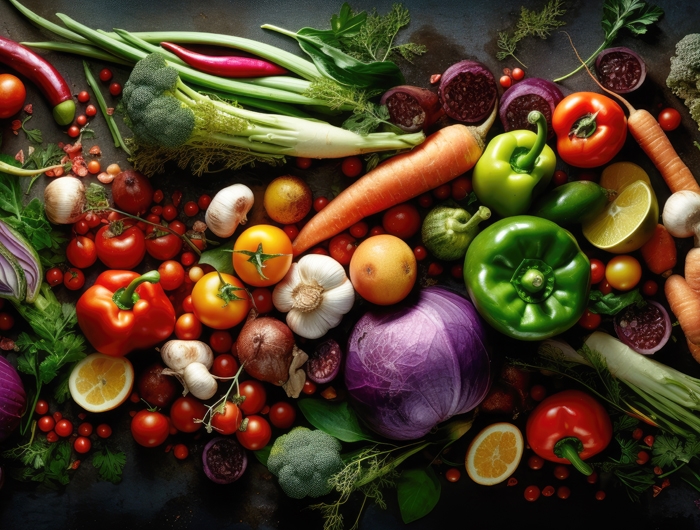Simple, inexpensive ways to eat more fruit and veggies

Gheorghita - stock.adobe.com.
The CDC says 90 percent of Americans don’t eat enough vegetables and 87 percent aren’t getting enough fruit. There’s good news, though: We’re not falling as short as you’d think, and you don’t have to rearrange your life or spend a fortune to add in what’s missing. Here’s how to eat more plants without breaking the bank or spending all day in the kitchen.
Current Dietary Guidelines say adults who eat around 2,000 calories per day should get 2 cups of fruit and 2.5 cups of vegetables each day. Most of us aren’t quite getting there, though—the average American is eating about a cup of fruit and around 1 to 1.5 cups of vegetables daily.
Eating plenty of vegetables (and fruit) is a great way to rack up potassium, which helps lower blood pressure. That may help explain why people who eat the most vegetables and fruit have a lower risk of heart disease and stroke than those who eat little or none.
Learn more at NutritionAction: Veg out! 5 reasons to eat more veggies
How much is a serving of fruit or veggies?

For most fresh, frozen, or canned fruits and vegetables, ½ cup is a serving. For whole fruit, like apples and oranges, one piece of fruit equals one serving. For dried fruit, which is more concentrated (in nutrients and calories) than its fresh counterparts, the serving size moves down to ¼ cup. Avocados, which are a great source of healthy fats, get a smaller serving size, too: 1/3 of a medium avocado adds another tally toward your daily goal.
The bright side is that small serving sizes are easy to incorporate into our current diets. If you’re regularly eating some fruit, adding a small apple or peach will get you to your goal.
Learn more at NutritionAction: How eating more plants can sustain your brain
How to eat more fruits and vegetables

Making dramatic diet and lifestyle changes all at once can be overwhelming and expensive, and odds are the changes won’t stick, anyway. And you don’t have to be vegan or vegetarian to get enough servings of fruits and vegetables each day.
To increase your fruit and veggie intake, just … add a little more here and there. The MyPlate goals make this easy to judge visually: Fill half your plate with fruits and vegetables.
If you can’t get to half your plate each day, don’t stress. Add what you can where you’re able, and over time, your average daily servings will increase and you’ll have built a healthy habit of looking for ways to incorporate more fruit and vegetables into your daily menu.
Learn more at NutritionAction: Tips for buying, ripening, and eating fruit
Adding fruits and vegetables to your diet
Here are some simple, achievable, affordable ways to boost your daily fruit and vegetable servings:
Break out the blender
Plain Greek yogurt, water or plant milk, and some fruit and veggies are the makings of a flexible, inexpensive, and fast daily smoothie. Need guidance? Here’s what’s in the best smoothies and shakes. (Spoiler: It’s plain Greek yogurt, water or unsweetened plant milk, and fruit and vegetables.)
Add another serving of vegetables into your planned meal

Making spaghetti? Toss a diced zucchini in the sauce. Rice and other grains make a great canvas for sauteed onions or leafy greens, and can be cooked with vegetable stock instead of water. Add a side of sliced raw veggies to your lunchtime sandwich—try crunchy cucumbers or bell peppers. Soups are the perfect place to add more of any vegetable the recipe calls for—an extra carrot, another half cup of diced peppers, a can of tomatoes. Add broccoli to your favorite casserole or toss some shredded cabbage into your regular fried rice recipe.
Don’t blow your grocery budget on foods you won’t eat
You don’t have to stock up on exotic produce to meet the daily serving guidelines. Frozen and canned produce count, they’re just as nutritious as fresh produce, can be stored long-term, and are perfect for bulking up less substantial meals. (Look for varieties with no added salt or low sodium.) Add half a cup of thawed frozen spinach to your favorite pasta, slightly thawed frozen blueberries to your oatmeal, stir a drained can of corn into a batch of chili, or scatter some pineapple chunks over a pizza before baking.
Start snacking

A cup of grapes, a banana, or an apple makes a great snack between meals, costs very little, and will provide some fiber, carbohydrates, and vitamins to carry you through to dinner. Veggies with dip make a low-prep, no-cook snack perfect for any afternoon. We like hummus with just about any vegetable you can eat raw, but carrots, bell peppers, and cucumbers are great places to start.
Try something new
Pick an interval that works for you—once a week, twice a month—to try a new fruit, vegetable, or recipe. If you like it, keep it in the rotation. If not, try something else next time. For new ways to use favorite ingredients, check out USDA’s MyPlate printable resources, which include guides like “Frozen Corn 5 Ways," and any of The Healthy Cook’s cookbooks or recipes from NutritionAction.
Support CSPI today
As a nonprofit organization that takes no donations from industry or government, CSPI relies on the support of donors to continue our work in securing a safe, nutritious, and transparent food system. Every donation—no matter how small—helps CSPI continue improving food access, removing harmful additives, strengthening food safety, conducting and reviewing research, and reforming food labeling.
Please support CSPI today, and consider contributing monthly. Thank you.

The latest
Our best (free) healthy tips
Our free Healthy Tips newsletter offers a peek at what Nutrition Action subscribers get—scrupulously researched advice about food of all kinds, staying healthy with diet and exercise, and more.

